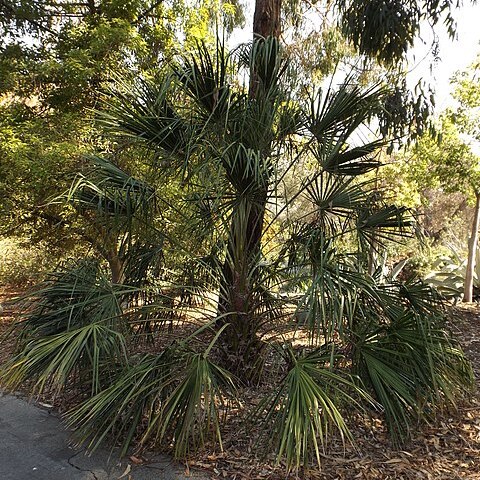Trunk to 28 m tall, 15–20 cm diam., pale grey, smooth. Leaves 30–60 in an open rounded or inverted-conical crown; petiole 150–230 cm long, 15–25 mm wide, smooth or with small marginal thorns; leaf base purple; leaf blade ±circular, 100–150 cm long, coriaceous, dark green, glossy, abaxially glabrous, divided to near middle or more; segments 60–84, drooping distally, deeply bifurcate, with attenuate lobes. Inflorescence 150–300 cm long, branched to 3 orders; bracts sparsely scaly; rachillae minutely pubescent. Flowers solitary or in sympodial clusters of 2–5, funnel-shaped, cream; sepals narrowly triangular, 0.7–1.5 mm long, subacute, fleshy; petals broadly ovate, 1.2–2 mm long, thickened at apex, fleshy; stamens c. 1.5 mm long. Fruit globose to pyriform, 10–12 mm diam., purple-black. Seed ellipsoid, 8–9 mm long.
More
A palm with a smooth grey trunk. It can be 20-27 m tall. The trunk is 25 cm across. The trunk is smooth and pale grey to white. The leaves are bright green and form a large crown. The leaves are 1.3-1.6 m long. These arch out on long slender leaf stalks. The stalks are 1.6-2.3 m long. The leaf blades are divided into narrow drooping segments. The flowers are cream. The fruit are 1.5 cm across. They are round and dull purple.
A tropical plant. It suits tropical and subtropical climates. It occurs naturally in coastal areas north of Townsville in Australia. It grows in colonies along stream banks. It grows from sea level to 110 m altitude. It prefers well-drained organically rich soil. Seedlings need shelter from the sun. In Townsville palmetum. It suits hardiness zones 10-12.
More
Grows in coastal and near-coastal regions on the landward side ofmangroves, open forest and seasonally dry swamp forest on coastal plains andadjacent foothills, and along the margins of streams and estuaries.


